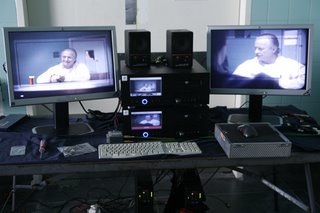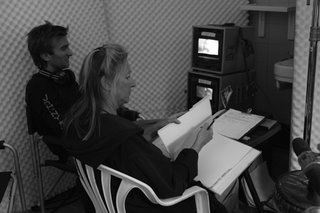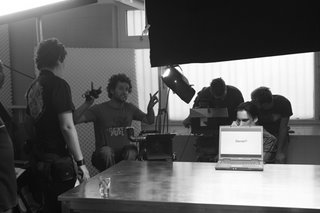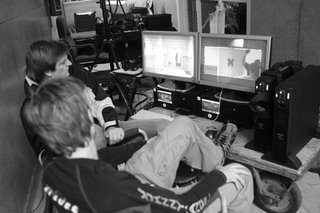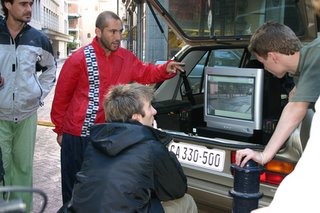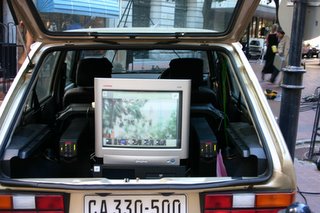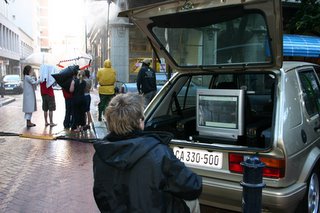Imagine a recording device the size of any prosumer camera like the Sony HVR-Z1 or the JVC GY-HD100. Small enough to be comfortably mounted on a steady-cam, yet all the power of a professional HD camera with 1920x1080 resolution image acquisition. EVE is the fist camera to  revolutionize the “indie film” world in both size and performance. The ability to record in HD 1920x1080 depth as film stock and all of the benefits of a digital environment.
revolutionize the “indie film” world in both size and performance. The ability to record in HD 1920x1080 depth as film stock and all of the benefits of a digital environment.
No more having to waste money on digitizing film stock or having to shoot less footage due to budget constraints. Now you can shoot clean "True Eye" footage on set with immediate access for editing, animation or grade. Imagine the amount of time saved, shooting a film with the same depth as film stock and all of the benefits of a digital environment.
What does one gain from a digital environment. More control on what you shoot, changing the color matrix and comparing footage before you even shoot the scene! Exposure meter, color meter, digital zoom, element zoom, element spotter, focus assist... All of these tools are available to make for a less painful shoot, spending less time having to calculate things which can be done in the comfort of your VT workstation. All this while the footage shot is still RAW!
EVE is really easy to setup. A PC attached to the CMOS camera head with a PL mount for the 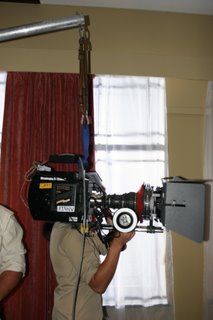 prime lenses, 16mm or 35mm. Think of having a bigger monitor to watch your footage and compare sharpness, contrast, etc?.. It can be done. Want to edit your footage immediately while on set? It can be done.
prime lenses, 16mm or 35mm. Think of having a bigger monitor to watch your footage and compare sharpness, contrast, etc?.. It can be done. Want to edit your footage immediately while on set? It can be done. MINI EVE
Lets assume EVE is the chicken then MINI 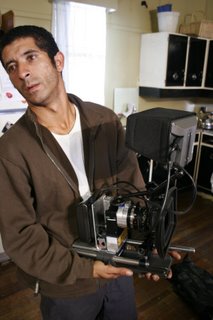 EVE is the egg. What do I mean by this? Allow me to explain...
EVE is the egg. What do I mean by this? Allow me to explain...
Tight spaces to shoot in... Front of a car POV (Point Of View), while driving at high speeds. Shooting interior of a mini cooper while driving and looking around like a first person POV. How about shooting live action first person shooter? Now you can without having to lug around a heavy camera. The only down side to this configuration is that you are limited by a network cable used to record the footage and a VT workstation fast and powerful enough to capture full frame master footage and not reference image. This chip is easily mountable to a car or even a hard hat without the heavy weight attached to it, in other words the body of the camera...
WAFIAN HR-1
The Wafian HR-1 is a direct-to-disk recorder with HD-SDI & HD component video. It has been our front line VT Station - footage recorder on location for the movie. It is now our edit suite. Recording to the Wafian HR-1 improves the visual quality of footage by avoiding on camera compression and limited bandwidth of HD tape  formats. Unlike fixed bit rate codecs such as DVCPRO HD and HDCAM, camera sensor data is recorded directly to a CineForm RAW format preserving the original pixel data.
formats. Unlike fixed bit rate codecs such as DVCPRO HD and HDCAM, camera sensor data is recorded directly to a CineForm RAW format preserving the original pixel data.
With the HR-1 footage is immediately available for instant preview and on site editing via Adobe Premier Pro software. Saving you time and money from recording to film stock, developing the negatives as well as transportation costs, etc... The HR-1 is capable of recording approximately 18 hours of footage at 1920x1080 progressive capture, edit ready.
Other than being a direct-to-disk-recorder it can be used for many applications such as computer animation, compositing, rotoscoping, post production, green screen, etc... The all in one solution for on-site editing.
MOTU TRAVELER
The MOTU was used for recording approximately 4 to 6 channels of audio to a laptop at 24-bit, 96KHz sample rate recording ability, it can record 192KHz as well. Reason for using the MOTU Traveler over other hard disk recorders is that you have the ability to edit on-site with the Traveler acting as your sound card. So it basically becomes an on-site sound editing suite, with the ability to record at high sample rates and have instant playback as well as better file management. For the movie we recorded using 2 condenser microphones, 2 wireless lapel microphones plus the addition of a background microphones. It is compatible with most programs, but the software of choice happened to be Adobe Audition which has an easy to use interface and pristine sound quality up to 192KHz, 32-bit.
record 192KHz as well. Reason for using the MOTU Traveler over other hard disk recorders is that you have the ability to edit on-site with the Traveler acting as your sound card. So it basically becomes an on-site sound editing suite, with the ability to record at high sample rates and have instant playback as well as better file management. For the movie we recorded using 2 condenser microphones, 2 wireless lapel microphones plus the addition of a background microphones. It is compatible with most programs, but the software of choice happened to be Adobe Audition which has an easy to use interface and pristine sound quality up to 192KHz, 32-bit.
It has 4 XLR balanced inputs with an addition of 4 extra balanced/unbalanced quarter inch jacks, analog inputs. ADAT optical digital I/O, SPDIF and AES/EBU digital I/O provide a total of 20 inputs and 22 outputs. The unit is also bus powered from the computer's FireWire port or standard battery pack for complete portability.
CINEFORM RAW
CineForm has developed new patent-pending technology called CineForm RAW. CineForm has extended acclaimed wavelet codec algorithms to lightly compress the raw data from the camera into 10-bit CineForm RAW files. Directly compressing the sensor data eliminates the multiple stages of transform processing traditionally performed inside the camera, ensuring the highest dynamic range and visual quality for the images. The data which is lightly compressed into CineForm RAW at a ratio of about 5:1 for 1920x1080 10-bit data, substantially less than any other in-camera format. For more information on CineForm RAW codec check out their site at: http://cineform.com/technology/cineform_RAW.htm
FINAL
The production phase of the movie has come to an end... Total figures are 6TB of total storage, of which 230 hours of RAW 1080P footage for the feature "Spoon", 20 hours of 720P "Spoon" coverage and 70 hours of behind-the-scenes coverage in DV format... 230 hours edited to approx 100 minutes... Good Luck with the edit “Inspired Minority”.
A very big thank you to everyone involved in the pre-production and the production of our feature film, THANK YOU for all your support, dedication and patience during this process.
Special thanks to: CineForm, Silicon Imaging, Wafian, One8Six, CineGate.
This is Phase 2 – COMPLETE.






